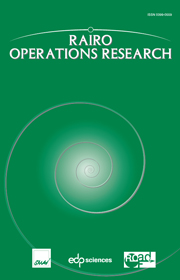Article contents
Scheduling Precedence Task Graphs with Disturbances
Published online by Cambridge University Press: 15 December 2003
Abstract
In this paper we consider the problem of scheduling precedence task graphs inparallel processing where there can be disturbances in computation andcommunication times. Such a phenomenon often occurs in practice, due to ourinability to exactly predict the time because of system intrusion like cache miss and packet transmission time in mediums like ethernet etc. We propose a method based on the addition of some extra edges to protect the initial scheduling from performing badly due to such changes and provide an upper bound on theperformance guarantee for the scheduling algorithms. Moreover, this construction guarantees a result at least as goodas the result obtained for the initial static scheduling.We also show that this construction is a minimal set in context of partially on-line scheduling.
- Type
- Research Article
- Information
- Copyright
- © EDP Sciences, 2003
References
- 5
- Cited by


